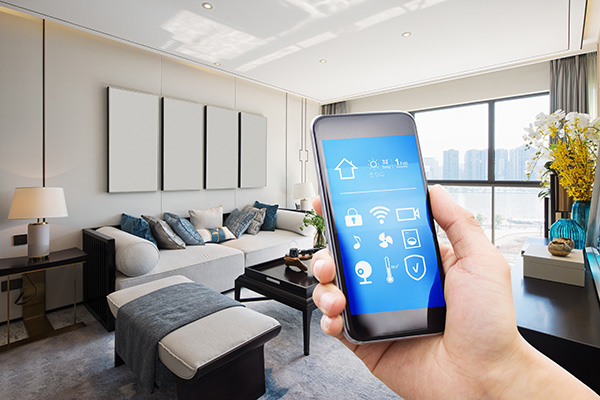The high tech home evolution

Smart home technology is one of the fastest growing consumer categories, with a recent study finding that 56% of adults have bought the latest must-have smart home tech including Wi-Fi controlled security cameras, heating systems and speakers. Consumers can choose from an ever-increasing array of connected devices and apps to remotely control their home, simply by tapping their smartphone screen. But how are they making a difference to everyday life? And how is technology evolving to speed up the initial home buying process?
The Smart Home
Devices and apps
Smart locks eliminate the need for a key or key fob entirely, allowing you to open the door with a code or straight from your smartphone – being able to let visitors in without having to be there yourself.
One of the most well-established smart home technologies is the smart thermostat, which enables you to adjust the heating remotely using your smartphone. The devices can even save you money by learning what temperature you like and when, so that it can control the heating more cost-efficiently.
You can now control the lights in any room with your phone. Connected light bulbs not only enable you to remotely switch the lights on and off, you can also dim them to your required level or change the colour to suit your mood. You can even set timers and wake-up lights.
Many ‘smart fridges’ have a camera inside the fridge, so families can keep track of stocks of food. Users can check if they need milk by ‘looking through’ the camera via an app on their smartphone while in the supermarket.
Augmented reality
One of the fastest growing technologies, AR is all about superimposing computer-generated images on top of your view of reality, thus creating a composite view that augments the real world. With just a smartphone and by using AR apps, consumers can re-imagine and re-design their space, so they can see what new paint, decor and furniture will look like in their home before committing to a purchase – reducing buyer remorse and returns.
Innovation in the home buying process
Virtual viewing
VR house viewings are transforming the property market, allowing house hunters to go on a virtual property tour from the comfort of their home, lessening time wasted visiting unsuitable properties falsely portrayed by excessive photoshopping and wide-angle lenses.
Home buyers can use a virtual reality headset for the most immersive experience. They can also manually click through a virtual space on their smartphone, tablet or computer. The virtual visit is an interactive 360 degree viewing experience that allows people to freely look around, explore and access relevant information whilst moving at their own pace between virtual hotspots positioned in each room. As they ‘move around’ the property they can gauge factors such as ceiling heights and wall conditions as they would in real life. Estate agents have reported virtual viewing reducing the number of physical viewings although increasing the ratio from viewing to offer, saving them time when showing people around. Some have even attributed offers being made from abroad based solely on a VR viewing.
Live chat and chatbots
With potential buyers house-hunting at all times of days, property portals and estate agents are unable to respond to all queries at all times of the day, which means that leads can be lost. One solution agents are employing is live chat. The online chat windows appear on websites to talk to customers, answering typical questions and helping them progress with their purchase. Live chat can be a powerful addition to an agency’s arsenal, connecting them with leads when they are deciding to make a purchase and, by pre-qualifying them to some degree, minimising any drop-off.
Research by Giosg highlights the most frequent type of chat conversations include booking a valuation (30 per cent), making an enquiry (28 per cent), a general enquiry (20 per cent) and technical issues (5 per cent). While chatbots are less able to provide comprehensive customer service, they are instead efficient at capturing lead contact details which can help to speed up the buying process.
Overall, it is clear that consumers are the driving force behind these rapid technological advancements in the property industry, with the demand for Smart Home tech being a clear indicator that home owners want tools to make their lives seamless and convenient. Pixel’s interactive systems provide these benefits at the very start of the home buying journey, giving home buyers all the information they need to make confident buying decisions.
Found this interesting? Sign-up to our newsletter and get more of our informative property related content straight to your inbox.


